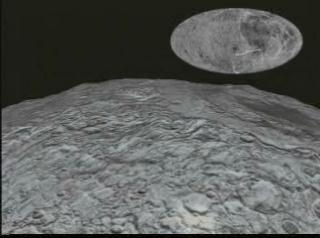Lunar Rotation and Flyby from Clementine Data
Clementine was a joint project between the Strategic Defense Initiative Organization and NASA. The objective of the mission was to test sensors and spacecraft components under extended exposure to the space environment and to make scientific observations of the Moon and the near-Earth asteroid 1620 Geographos. Clementine was launched on 25 January 1994 at 16:34 UTC (12:34 PM EDT) from Vandenberg AFB aboard a Titan II G rocket. After two Earth flybys, lunar insertion was achieved on February 21. Lunar mapping took place over approximately two months, in two parts. The first part consisted of a 5 hour elliptical polar orbit with a perilune of about 400 km at 28 degrees S latitude. After one month of mapping the orbit was rotated to a perilune of 29 degrees N latitude, where it remained for one more month. This allowed global imaging as well as altimetry coverage from 60 degrees S to 60 degrees N.
Lunar rotation and surface flyby using LIDAR data from Clementine

Video slate image reads "Lunar Topography from the Clementine Mission".
For More Information
Credits
Please give credit for this item to:
NASA/Goddard Space Flight Center
Scientific Visualization Studio
-
Visualizer
-
Cindy Starr
(Global Science and Technology, Inc.)
-
Cindy Starr
(Global Science and Technology, Inc.)
-
Scientists
- David Smith (NASA/GSFC)
- Maria Zuber (Massachusetts Institute of Technology)
- Frank Lemoine (NASA/GSFC)
- Gregory Neumann (Johns Hopkins University)
Missions
This page is related to the following missions:Series
This page can be found in the following series:Related papers
Maria T. Zuber, David E. Smith, Frank G. Lemoine, Gregory A. Neumann, The Shape and Internal Structure of the Moon from the Clementine Mission, Science, 16 December 1994, pp. 1839-1843.
Maria T. Zuber, David E. Smith, Frank G. Lemoine, Gregory A. Neumann, The Shape and Internal Structure of the Moon from the Clementine Mission, Science, 16 December 1994, pp. 1839-1843.
Datasets used
-
Lunar topography [Clementine: LIDAR]
ID: 267
Note: While we identify the data sets used on this page, we do not store any further details, nor the data sets themselves on our site.
Release date
This page was originally published on Friday, June 9, 1995.
This page was last updated on Wednesday, May 3, 2023 at 2:00 PM EDT.
